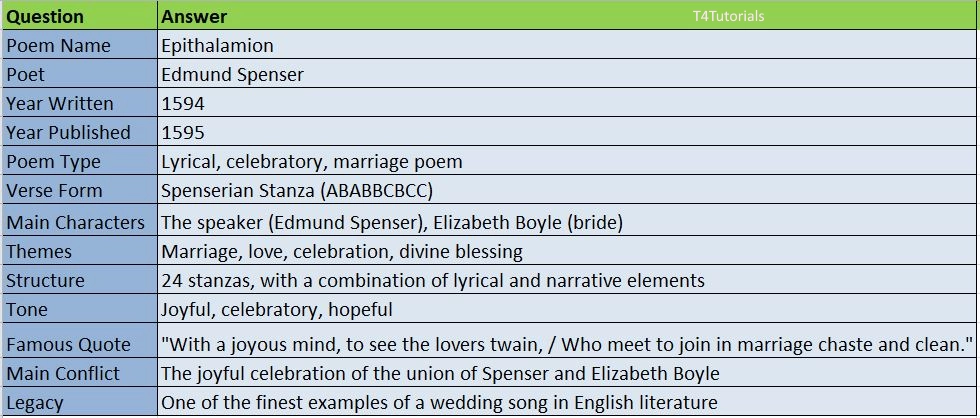Summary:
Epithalamion is a celebratory poem written by Edmund Spenser to commemorate his marriage to Elizabeth Boyle in 1594. The poem is composed of 24 stanzas, each with a specific rhyme scheme and structure. It is a lyrical and jubilant work that blends elements of classical tradition with Elizabethan poetic forms. The poem’s primary theme is the celebration of marriage, love, and the divine blessing that comes with union. The structure of the poem is divided into several parts: it begins with an invocation to the Muses and the goddess Hymen, the god of marriage, to help the poet celebrate the union. The poet then praises his bride and their love, describing the wedding procession and various symbolic elements like the rising sun, flowers, and the music of the wedding ceremony. Throughout the poem, Spenser praises the virtues of his bride, Elizabeth, and their deep, mutual love. There are also elements of mythological allusions, where the poet invokes classical figures to support the celebration of love. As the poem progresses, Spenser prays for blessings on their marriage, hoping that it will be fruitful and long-lasting, with children and joy. He asks for divine protection and peace, hoping that their love will endure through time. Epithalamion is considered one of Spenser’s greatest works, showcasing his mastery of the elegiac and celebratory form, while also serving as an example of Elizabethan courtly love poetry.
10
Score: 0
Attempted: 0/10
Subscribe
| Question | Answer |
| Poem Name | Epithalamion |
| Poet | Edmund Spenser |
| Year Written | 1594 |
| Year Published | 1595 |
| Poem Type | Lyrical, celebratory, marriage poem |
| Verse Form | Spenserian Stanza (ABABBCBCC) |
| Main Characters | The speaker (Edmund Spenser), Elizabeth Boyle (bride) |
| Themes | Marriage, love, celebration, divine blessing |
| Structure | 24 stanzas, with a combination of lyrical and narrative elements |
| Tone | Joyful, celebratory, hopeful |
| Famous Quote | “With a joyous mind, to see the lovers twain, / Who meet to join in marriage chaste and clean.” |
| Main Conflict | The joyful celebration of the union of Spenser and Elizabeth Boyle |
| Legacy | One of the finest examples of a wedding song in English literature |